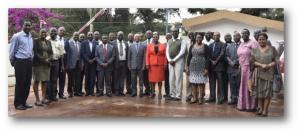WHO hosts stakeholder meeting to finalize the Integrated Vector Management strategy
November 2016 - The Ministry of Health National Malaria Control Program (NMCP) convened a consultative meeting, at the World Health Organization (WHO) Country Office in Uganda, to update stakeholders on the process of developing an Integrated Vector Management (IVM) strategy for Uganda and gather their inputs into the draft strategy. During the meeting, NMCP stressed the need for an IVM strategy for Uganda as the country moves towards the 2030 elimination target.
The stakeholders noted that IVM is the first objective of the Uganda Malaria Reduction Strategy (UMRS) 2014-2020 and that while other objectives like case management have strategies and guidelines, IVM does not.
Furthermore, the participants observed that the IVM strategy would enable the NMCP to; define the policy, understand institutional arrangements, and implementation of IVM.
The stakeholders were also updated on the process of developing the IVM strategy, noting that the completion of the document and desk review processes. They were further informed that consultative stage where stakeholders input into the document is critical.
A presentation on the draft IVM strategy highlighted the Malaria situation in Uganda, the UMRS, IVM strategy, Vector control needs assessment, and major challenges in Uganda, as well as IVM implementation plan as the critical sections of the document.
The stakeholders also recognized and thanked ABT associates for their input on the IVM guidelines which will inform the strategy. They further agreed to develop the earlier work of ABT Associates into an IVM implementation guideline. The stakeholders also pointed out that the draft strategy be adjusted to include cross border and malaria control in institutions.
At the end of the meeting, the stakeholders nominated a core team to finalize the two documents. The meeting was attended by NMCP staff, WHO, United Nations Children’s Fund (UNICEF), and academia.



